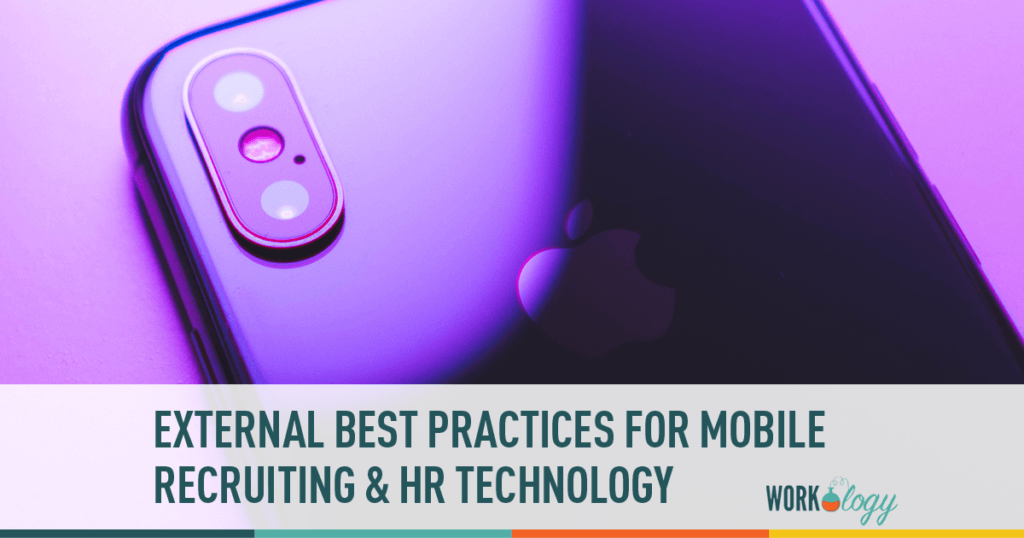This is Part 3 of a series on Workplace Trends in Mobile and Technology for the Human Resources Industry. Check out Part 1 here. Download the full essay on how mobile & technology are changing HR as featured in J. Wiley & Son’s Summer 2012 issue of Employment Relations Today Journal by downloading here. I’ll be publishing the materials as part of an ongoing series on mobile recruiting and HR technology.
External Engagement Methods: Communication & Recruitment
When it comes to companies selecting external engagement methods and technology to reach employees, consumers, and candidates, the world is their oyster. There are millions of platforms, methods, and means to engage audiences, but the key to finding the most effective means is to understand and evaluate the intended target market.
For the purposes of this section of the article, we use social networking to mean a tool to recruit, retain, and develop relationships with past and present employees as well as future candidates. Companies are considering their employment social-media channels as a complement to their external-facing marketing efforts, or employment branding. It is a new phenomenon that companies are evaluating and planning to use social media and other external channels to build relationships with job seekers who are often consumers as well.
Consumers love to engage brands online. Whether it is through Facebook by “liking” a company brand page or messaging the company via Twitter, the online relationship elicits a personal response. Development of company brands and relationships with customers and job seekers is a foundational piece of “business anthropology.” Potential employees can engage the brand in a safe environment, learning about the organization prior to completing the online application. Job seekers have the opportunity to self-select themselves from the process before the interview process or are on the job increasing candidate quality and lowering new hire employee turnover.
Recruiting on Twitter with Hashtags
For example, a Fortune 500 company that is involved in the telecom industry has a brand that is strong, recognized, and respected. This company uses social media as an engagement platform, pushing out job openings from various targeted Twitter feed accounts using specific hashtags by city like #atl, by job like #ruby, and other common tags #jobs and #jobs. (On Twitter, hashtags are extremely important and serve as a crowdsourcing Twitter library and cataloging system. This company takes the opportunity to use social media not only as a form of online job posting and web-traffic driver to the company’s careers page, but also as a means of engaging job seekers and the employee community using traditional social networking sites like Twitter, Facebook, and LinkedIn to answer questions, check the status of job seekers’ applications, and respond to other requests. The company also uses nontraditional social-networking platforms such as chat rooms, forums, and communities like GlassDoor.com to build relationships with job seekers as they visit the site to get the inside scoop on a company’s culture and interview and selection process directly from the job seeker themselves.
Blogging is also an effective tool to help potential job seekers learn about your company’s culture. This is important as popular tech companies like Apple, Google, and Facebook average thousands of job seeker applications a day. A blog can help job seekers opt-out of the application process by understanding how their own personal style and personality might integrate with your company’s established cultural norms, values, and work environment.
Is Your Company Career Page Mobile Recruiting Ready?
With regard to the recruiting and hiring process, all roads lead to the company careers or career page, and because a growing percentage of Internet users and applicants are using mobile and smart-phone devices as their primary Internet surfing tool, it makes sense that companies would need to integrate mobile into their job-application process. Jibe, an HR technology start-up, recently launched the first mobile ATS and career page, which allows job seekers to apply fully using their mobile devices. These job seekers can integrate their LinkedIn profile information directly into their applications, upload cover letters or resumes if they are stored in the cloud using storage tools like DropBox; DropBox will even e-mail the resumes add them directly to job seekers’ applications.
The mobile trend will only continue as companies are scrambling to consider the candidate experience at every turn of the hiring and application process. As employees build networks and relationships online, just as consumers do, they are using these outward-facing platforms to share their candidate experiences, influencing other job- seeker and applicant decisions. Companies need to consider these opportunities to engage job seekers, regardless of whether they become employees, and focus on making all candidates’ experiences pleasant and full of feedback, taking into account candidates’ technology preferences.
This is Part 3 of a series on Workplace Trends in Mobile and Technology for the Human Resources Industry. Check out Part 1 here. Download the full essay on how mobile & technology are changing HR as featured in J. Wiley & Son’s Summer 2012 issue of Employment Relations Today Journal by downloading here.
No traducir con doble clic
No mostrar el botón flotante
- Añadir a la guía de conversación
- No hay listas de palabras para Inglés -> Español…
- Crear una nueva lista de palabras…
- Copiar










One Comment
Recruiting via Twitter is a great way to hone in on your audience base. Businesses can also use free services like those provided at my own company, Ongig (http://ongig.com), to create job descriptions with socially connectable qualities by using visuals with videos, photos, and thumbnails of people in the community around every job that can be created by employers in less than 15 minutes. Job descriptions using video are viewed more than those without!
Comments are closed.